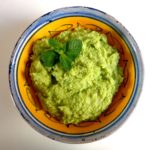 Consider this a Mediterranean version of guacamole. Fava beans (aka broad beans) are cooked to tenderness and puréed with olive oil, lemon and garlic, with a little cayenne pepper for bite. A perfect spread as warm spring days edge toward the sumptuous evenings of summer. Right? That’s what I thought when I made this spread for guests a couple of weeks ago. But I was wrong. April in Paris was a bust this year. Truly the cruelest month…
Consider this a Mediterranean version of guacamole. Fava beans (aka broad beans) are cooked to tenderness and puréed with olive oil, lemon and garlic, with a little cayenne pepper for bite. A perfect spread as warm spring days edge toward the sumptuous evenings of summer. Right? That’s what I thought when I made this spread for guests a couple of weeks ago. But I was wrong. April in Paris was a bust this year. Truly the cruelest month…
Purée de fèves épicée / Tangy fava spread
But even on cold, gray, rainy days, this spread will brighten up a meal. It may be served during cocktail hour on toast, or at the table as a starter alongside other Mediterranean salads — topped with roasted pumpkin seeds or a bouquet of fresh mint or cilantro. It is definitely a dish for spring, when fava beans are in season. You can find them in outdoor markets in France beside other seasonal produce — artichokes, peas, strawberries.
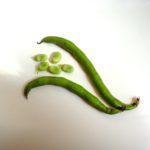 I first encountered this spread maybe 20 years ago at the home of a Lebanese woman who lived around the corner from me in Paris. A superlative cook, she used canned fava beans for the spread, and this is a fine option in other seasons. You can also make the spread with frozen fava beans, a huge convenience as it allows you to dispense with shelling the beans (and they need to be shelled twice…). But in spring, fresh beans are best.
I first encountered this spread maybe 20 years ago at the home of a Lebanese woman who lived around the corner from me in Paris. A superlative cook, she used canned fava beans for the spread, and this is a fine option in other seasons. You can also make the spread with frozen fava beans, a huge convenience as it allows you to dispense with shelling the beans (and they need to be shelled twice…). But in spring, fresh beans are best.
This recipe is adapted from one of my favorite cookbooks, Petit Larousse des recettes du potager (Larousse, 2008), a compendium of recipes featuring garden veggies. Their original version of the fava spread uses sesame seeds instead of pumpkin seeds, and ground cumin in place of cayenne. Try it that way too.
The Larousse, which calls favas ‘the princess of peas’, has three more recipes featuring the humble bean: cold blended soup of favas and cottage cheese; a salad of baby favas, green beans, alfalfa sprouts, mint and quinoa; and a warm salad of favas, ginger and green onions. And that is just the fava part of the 37-page bean section, which also covers coco beans, green beans, peas and snow peas. It is a wonderful book for anyone interested in healthy cooking, and may hold special appeal for the vegetarians and vegans among you.
And on that note, I will wish you all warm sunny days in May. Frozen ice was falling from the sky in Paris three nights ago. May it return to the clouds and stay there till next winter.
Happy cooking.

 The other day I wandered into a local lunchtime place and was served the most delectable quiche I’d tasted in a long time. Both light and rich, it veritably hummed with the flavors of spring — in the form of green asparagus and oyster mushrooms. The place was the Rose Bakery. I wrote to them to ask for the recipe, but they didn’t reply. Never mind. I made it anyway.
The other day I wandered into a local lunchtime place and was served the most delectable quiche I’d tasted in a long time. Both light and rich, it veritably hummed with the flavors of spring — in the form of green asparagus and oyster mushrooms. The place was the Rose Bakery. I wrote to them to ask for the recipe, but they didn’t reply. Never mind. I made it anyway.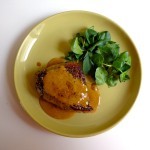 A dish that can bring down the house — literally — is steak au poivre, the classic French bistro offering of tender beef crusted with cracked black pepper and topped with a cognac-cream sauce. When I embarked on this recipe, my kitchen nearly went up in flames — twice! The skillet I used to pan sear the steak caught fire when I started the sauce, with bright yellow flames shooting two feet into the air. Oh là là…
A dish that can bring down the house — literally — is steak au poivre, the classic French bistro offering of tender beef crusted with cracked black pepper and topped with a cognac-cream sauce. When I embarked on this recipe, my kitchen nearly went up in flames — twice! The skillet I used to pan sear the steak caught fire when I started the sauce, with bright yellow flames shooting two feet into the air. Oh là là… One recent Sunday during a visit to England, I was lucky enough to be invited to lunch in the picturesque town of Sevenoaks, in Kent south of London. My friends served me a spectacular meal, beginning with a salad of ruby-streaked blood oranges piled on thinly sliced finocchio and red onion, and scattered with Kalamata olives and watercress. Blood oranges would still be in season when I got home to France. I had to have the recipe.
One recent Sunday during a visit to England, I was lucky enough to be invited to lunch in the picturesque town of Sevenoaks, in Kent south of London. My friends served me a spectacular meal, beginning with a salad of ruby-streaked blood oranges piled on thinly sliced finocchio and red onion, and scattered with Kalamata olives and watercress. Blood oranges would still be in season when I got home to France. I had to have the recipe. Can you imagine that tiramisu, the ubiquitous feather-light confection, did not exist half a century ago? It certainly was nowhere to be found in Paris when I arrived in the 1970s, having only just been invented (apparently), although its origins are in dispute. What cannot be contested is that this wonderful dessert of sweetened cheese layered with ladyfingers dipped in coffee is not only a crowd pleaser, but easy and fun to prepare.
Can you imagine that tiramisu, the ubiquitous feather-light confection, did not exist half a century ago? It certainly was nowhere to be found in Paris when I arrived in the 1970s, having only just been invented (apparently), although its origins are in dispute. What cannot be contested is that this wonderful dessert of sweetened cheese layered with ladyfingers dipped in coffee is not only a crowd pleaser, but easy and fun to prepare. Sea scallops, Brittany style — dusted with flour, tenderly sauteed in butter and drizzled with a creamy sauce — make a fine winter’s dish. But what does this recipe have to do with the Way of Saint James, the historic pilgrimage route to Santiago de Compostela in northwestern Spain? Quite a lot, as it turns out, for the saint known as ‘Santiago’ in Spanish is ‘Saint Jacques’ in French, and along the route he gave his name to the humble scallop.
Sea scallops, Brittany style — dusted with flour, tenderly sauteed in butter and drizzled with a creamy sauce — make a fine winter’s dish. But what does this recipe have to do with the Way of Saint James, the historic pilgrimage route to Santiago de Compostela in northwestern Spain? Quite a lot, as it turns out, for the saint known as ‘Santiago’ in Spanish is ‘Saint Jacques’ in French, and along the route he gave his name to the humble scallop.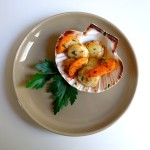 And why Brittany style? That’s a question I failed to answer, although my best guess is that scallops and butter are popular in the region. Brittany, of course, is surrounded by sea, and shellfish may be found there in abundance. The potato also has an important history in Brittany, where it came into wide use during a famine in the mid-18th century. In this recipe, the scallops may be paired with sliced potatoes, as shown in the photo above, or with potatoes boiled in their jackets. Another nice touch is to serve them in their shells.
And why Brittany style? That’s a question I failed to answer, although my best guess is that scallops and butter are popular in the region. Brittany, of course, is surrounded by sea, and shellfish may be found there in abundance. The potato also has an important history in Brittany, where it came into wide use during a famine in the mid-18th century. In this recipe, the scallops may be paired with sliced potatoes, as shown in the photo above, or with potatoes boiled in their jackets. Another nice touch is to serve them in their shells.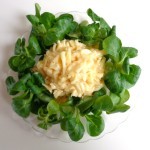 It is always a comfort, on a cold, damp Paris day, to walk into a bistro at lunchtime and encounter a plate of céléri rémoulade, the classic French starter of grated celeriac bathed in a tangy mustard mayonnaise. This earthy salad is one of the dishes I longed for when far from France for long periods on journalistic assignments. You won’t find it in Moscow or Manila, nor for that matter in many of the trendy new cafés sprouting up in Paris. But what it may lack in chic it makes up for in flavor. A good reason to make it at home.
It is always a comfort, on a cold, damp Paris day, to walk into a bistro at lunchtime and encounter a plate of céléri rémoulade, the classic French starter of grated celeriac bathed in a tangy mustard mayonnaise. This earthy salad is one of the dishes I longed for when far from France for long periods on journalistic assignments. You won’t find it in Moscow or Manila, nor for that matter in many of the trendy new cafés sprouting up in Paris. But what it may lack in chic it makes up for in flavor. A good reason to make it at home. Celeriac remoulade can be served on its own as a starter, set on a bed of tender leaves or garnished with fresh herbs. But here in France it is most commonly seen as part of the mixed veggie starter known as
Celeriac remoulade can be served on its own as a starter, set on a bed of tender leaves or garnished with fresh herbs. But here in France it is most commonly seen as part of the mixed veggie starter known as  And speaking of eggs, while preparing this week’s post I took time to revisit another of my favorite classic French starters —
And speaking of eggs, while preparing this week’s post I took time to revisit another of my favorite classic French starters —  The French colonial empire once stretched across the globe, with the happy result — once independence was restored to the colonized — that the cuisine of many cultures is now available in France. Poulet yassa, or chicken marinated in a sauce of onions, lemon juice and mustard, is one such happy dish. Originally from the Casamance region of southern Senegal, it is now highly popular throughout former French West Africa, and also in Paris.
The French colonial empire once stretched across the globe, with the happy result — once independence was restored to the colonized — that the cuisine of many cultures is now available in France. Poulet yassa, or chicken marinated in a sauce of onions, lemon juice and mustard, is one such happy dish. Originally from the Casamance region of southern Senegal, it is now highly popular throughout former French West Africa, and also in Paris. Back to Paris… Cold weather has finally set in, prompting me to revisit some of the winter dishes already posted here, with new photos. The first,
Back to Paris… Cold weather has finally set in, prompting me to revisit some of the winter dishes already posted here, with new photos. The first,  The second is a
The second is a 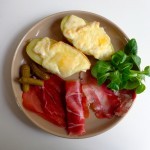 When winter comes to France, it’s time for raclette. This immensely popular dish of potatoes smothered in melted cheese, accompanied by cured meat and pickles, has come down from the Alps to become a favorite nationwide. It evokes memories of ski slopes, where of a snowy evening you could gather with friends to enjoy a restaurant meal of raclette, with a half-wheel of cheese brought to your table and melted under an electric grill.
When winter comes to France, it’s time for raclette. This immensely popular dish of potatoes smothered in melted cheese, accompanied by cured meat and pickles, has come down from the Alps to become a favorite nationwide. It evokes memories of ski slopes, where of a snowy evening you could gather with friends to enjoy a restaurant meal of raclette, with a half-wheel of cheese brought to your table and melted under an electric grill. On the eve of the end-of-year holidays, here is a recipe that is renowned in France for its excess-fighting qualities. Ah oui, mes amis — once the festivities are over, it’s time to take action to counteract the effects of all the wonderful holiday dishes, sweets and drinks we may have indulged in. Rustic cabbage soup is the antidote. In fact, it is an open secret among French women and men who want to start the new year in their best form.
On the eve of the end-of-year holidays, here is a recipe that is renowned in France for its excess-fighting qualities. Ah oui, mes amis — once the festivities are over, it’s time to take action to counteract the effects of all the wonderful holiday dishes, sweets and drinks we may have indulged in. Rustic cabbage soup is the antidote. In fact, it is an open secret among French women and men who want to start the new year in their best form.

